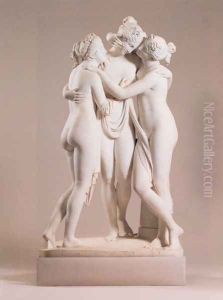Pasquale Romanelli Paintings
Pasquale Romanelli was an Italian sculptor who made significant contributions to 19th-century Italian art. Born on May 9, 1812, in Florence, Italy, Romanelli was part of a family with a rich artistic tradition. His father, Luigi Romanelli, was a notable sculptor, which provided Pasquale with an artistic environment from an early age.
Romanelli received his early training from his father and later attended the Accademia di Belle Arti in Florence, where he studied under the neoclassical sculptor Lorenzo Bartolini. Bartolini's influence was pivotal in shaping Romanelli's early style, which was rooted in the neoclassical tradition with a strong emphasis on anatomical precision and idealized forms. After Bartolini's death in 1850, Romanelli inherited his master's studio and clientele, which allowed him to establish himself as a prominent sculptor in Florence.
During his career, Romanelli produced a wide range of works including statues, busts, and religious figures. He was particularly known for his marble sculptures, which often depicted historical and mythological subjects. His works were characterized by their meticulous craftsmanship and elegance, which made him popular among both Italian and international patrons. Romanelli's sculptures were exhibited in various European countries, and he received numerous commissions from abroad, including from the United States.
Romanelli became an influential figure in the Florentine art community and served as a professor at the Accademia di Belle Arti. His legacy continued through his son, Raffaello Romanelli, who also became a prominent sculptor. Pasquale Romanelli's impact on Italian sculpture is remembered for its embodiment of the neoclassical style and its transition to a more modern sensibility. He passed away on December 8, 1887, in Florence. Today, his works can be found in museums, galleries, and private collections around the world, and they continue to be appreciated for their artistic merit and historical significance.
